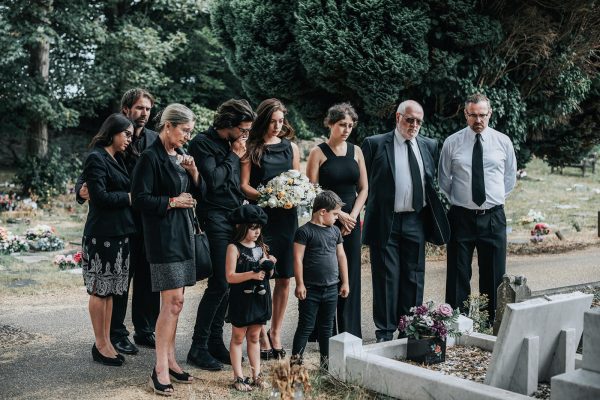
What to Wear to a Funeral
If you have never attended a funeral before, deciding what to wear to a funeral can be difficult. Black is considered the most popular funeral attire in Western cultures.
In times of loss, attending a funeral serves not only as a gesture of support for grieving loved ones but also as an opportunity to express sympathy and respect for the departed. While words may sometimes fail to convey the depth of our emotions, our choice of wears becomes a silent yet powerful means of paying homage to the deceased and demonstrating solidarity with those left behind. Navigating the delicate balance between personal expression and cultural sensitivity, the clothing we choose for such occasions plays a crucial role in acknowledging the solemnity of the moment. Going through the loss of a beloved one is undoubtedly a trying time and moment for the mourners, and choosing appropriate attire or clothing for a funeral is a small but significant way to show respect and empathy for the grieving family.
General Guidelines
1. Colors: Stick to muted and somber colors such as black, dark gray, navy blue, or deep purple. Avoid bright or flashy colors, as they may be considered inappropriate for the occasion and a disrespect to the deceased.
2. Clothing Style: Choose conservative and modest clothing for men, a dark suit with a tie is a classic and appropriate choice. Women can opt for a dress, skirt, or pantsuit, ensuring the overall appearance is dignified and not overly flamboyant. The emphasis should be on the solemn nature of the occasion rather than personal fashion statements shirts, and sneakers are generally not suitable for a funeral unless the family has explicitly specified a more casual dress code
3. Avoid Casual Attire: Funerals are solemn events that demand a level of formality. Casual attire, such as jeans, T-shirts, or sneakers, is generally discouraged unless the family has explicitly communicated a more relaxed dress code. Choosing formal or semi-formal wear underscores the importance of the event and reflects a collective commitment to honoring the memory of the departed.
4. Accessories: The principle of modesty extends to accessories. It’s advisable to keep jewelry and accessories understated, avoiding anything flashy or attention-grabbing. The focus should remain on the significance of the event rather than on individual adornments. This includes choosing accessories that do not generate unnecessary noise or distractions during the ceremony.
5. Cultural Sensitivity: Cultural diversity is a vital aspect of funeral practices. Different cultures may have unique customs and expectations regarding funeral attire. Understanding and respecting these cultural norms demonstrate a deep appreciation for diversity and an acknowledgment of the varied ways in which people express grief and honor their loved ones.
6. Weather Considerations: Practicality is another dimension to consider, especially if the funeral is outdoors or during extreme weather conditions. While maintaining the overall tone of respect, attendees may need to adapt their attire to suit the environment, ensuring comfort without compromising on the gravity of the occasion.
Different Types of Funerals and Clothing to Wear
1. Traditional Funeral: For a classic funeral service, adherence to the general guidelines is key. Whether held in a church or funeral home, the familiar sight of dark, respectful attire signifies a collective understanding of the solemnity associated with traditional ceremonies.
2. Military Funeral: If attending a military funeral, consider wearing a dark suit with a military-style tie or a dark dress for women. Veterans may choose to wear their military uniform.Veterans may choose to wear their military uniform, underscoring their dedication and service.
3. Cultural or Religious Considerations: Some cultures and religions have specific funeral attire customs. It’s advisable to research or inquire about these customs and dress accordingly. Whether it involves specific attire, symbolic colors, or traditional accessories, aligning one’s clothing with these practices expresses a deep respect for the deceased and their heritage..
4. Celebration of Life Service: In cases where the funeral is a celebration of the deceased person’s life, the dress code may be more relaxed. Still, it’s essential to maintain a level of respect and decorum.While maintaining a respectful demeanor, attendees may find flexibility in the dress code, allowing for more relaxed attire that reflects the joyous memories being celebrated.
Frequently Asked Questions on What to Wear to a Funeral
Can I Wear White to a Funeral?
While white is generally avoided, exceptions may exist based on cultural or familial preferences. Seeking guidance from the bereaved family or organizers ensures adherence to their specific expectations.
Is it Appropriate to Wear Religious Attire?
wearing religious attire is generally accepted, particularly if it holds significance to the deceased or the grieving family. Respectful incorporation of religious symbols pays homage to the spiritual aspects of the ceremony.
Can I Wear a Hat?
Traditionally, men remove their hats indoors as a sign of respect. However, women may choose to wear a hat, especially if it aligns with cultural or religious practices, adding a touch of dignity to their attire.
What About Children’s Attire?
Children should be dressed in subdued and respectful clothing, avoiding bright colors and flashy accessories. This approach fosters an environment of sensitivity and age-appropriate understanding.
Do I Need to Wear Formal Shoes?
While formal shoes are recommended, ensuring that shoes are clean and well-kept is essential. Dark-colored dress shoes or loafers are generally considered appropriate, contributing to an overall polished appearance
Wrap-Up
In moments of sorrow, our choice of funeral attire becomes a language of its own—an unspoken expression of empathy, support, and reverence for the departed and those left behind. If uncertainty persists, it is always appropriate to seek guidance from the family or organizers, demonstrating a commitment to honoring the wishes of those directly affected by the loss.

Leave a Reply